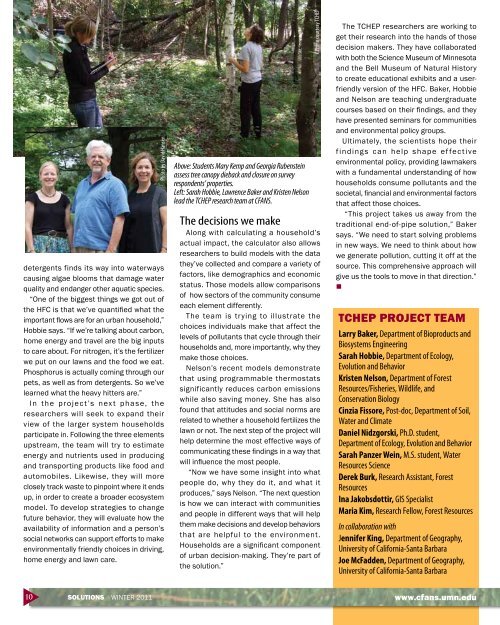PDF Version - College of Food, Agricultural and Natural Resource ...
PDF Version - College of Food, Agricultural and Natural Resource ...
PDF Version - College of Food, Agricultural and Natural Resource ...
Create successful ePaper yourself
Turn your PDF publications into a flip-book with our unique Google optimized e-Paper software.
detergents finds its way into waterways<br />
causing algae blooms that damage water<br />
quality <strong>and</strong> endanger other aquatic species.<br />
“One <strong>of</strong> the biggest things we got out <strong>of</strong><br />
the HFC is that we’ve quantified what the<br />
important flows are for an urban household,”<br />
Hobbie says. “If we’re talking about carbon,<br />
home energy <strong>and</strong> travel are the big inputs<br />
to care about. For nitrogen, it’s the fertilizer<br />
we put on our lawns <strong>and</strong> the food we eat.<br />
Phosphorus is actually coming through our<br />
pets, as well as from detergents. So we’ve<br />
learned what the heavy hitters are.”<br />
In the project’s nex t phase, the<br />
researchers will seek to exp<strong>and</strong> their<br />
view <strong>of</strong> the larger system households<br />
participate in. Following the three elements<br />
upstream, the team will try to estimate<br />
energy <strong>and</strong> nutrients used in producing<br />
<strong>and</strong> transporting products like food <strong>and</strong><br />
automobiles. Likewise, they will more<br />
closely track waste to pinpoint where it ends<br />
up, in order to create a broader ecosystem<br />
model. To develop strategies to change<br />
future behavior, they will evaluate how the<br />
availability <strong>of</strong> information <strong>and</strong> a person’s<br />
social networks can support efforts to make<br />
environmentally friendly choices in driving,<br />
home energy <strong>and</strong> lawn care.<br />
10<br />
SOLUTIONS WINTER 2011<br />
Photo by David Hansen<br />
Above: Students Mary Kemp <strong>and</strong> Georgia Rubenstein<br />
assess tree canopy dieback <strong>and</strong> closure on survey<br />
respondents’ properties.<br />
Left: Sarah Hobbie, Lawrence Baker <strong>and</strong> Kristen Nelson<br />
lead the TCHEP research team at CFANS.<br />
Photo courtesy TCHEP<br />
The decisions we make<br />
Along with calculating a household’s<br />
actual impact, the calculator also allows<br />
researchers to build models with the data<br />
they’ve collected <strong>and</strong> compare a variety <strong>of</strong><br />
factors, like demographics <strong>and</strong> economic<br />
status. Those models allow comparisons<br />
<strong>of</strong> how sectors <strong>of</strong> the community consume<br />
each element differently.<br />
The team is trying to illustrate the<br />
choices individuals make that affect the<br />
levels <strong>of</strong> pollutants that cycle through their<br />
households <strong>and</strong>, more importantly, why they<br />
make those choices.<br />
Nelson’s recent models demonstrate<br />
that using programmable thermostats<br />
significantly reduces carbon emissions<br />
while also saving money. She has also<br />
found that attitudes <strong>and</strong> social norms are<br />
related to whether a household fertilizes the<br />
lawn or not. The next step <strong>of</strong> the project will<br />
help determine the most effective ways <strong>of</strong><br />
communicating these findings in a way that<br />
will influence the most people.<br />
“Now we have some insight into what<br />
people do, why they do it, <strong>and</strong> what it<br />
produces,” says Nelson. “The next question<br />
is how we can interact with communities<br />
<strong>and</strong> people in different ways that will help<br />
them make decisions <strong>and</strong> develop behaviors<br />
that are helpful to the environment.<br />
Households are a significant component<br />
<strong>of</strong> urban decision-making. They’re part <strong>of</strong><br />
the solution.”<br />
The TCHEP researchers are working to<br />
get their research into the h<strong>and</strong>s <strong>of</strong> those<br />
decision makers. They have collaborated<br />
with both the Science Museum <strong>of</strong> Minnesota<br />
<strong>and</strong> the Bell Museum <strong>of</strong> <strong>Natural</strong> History<br />
to create educational exhibits <strong>and</strong> a userfriendly<br />
version <strong>of</strong> the HFC. Baker, Hobbie<br />
<strong>and</strong> Nelson are teaching undergraduate<br />
courses based on their findings, <strong>and</strong> they<br />
have presented seminars for communities<br />
<strong>and</strong> environmental policy groups.<br />
Ultimately, the scientists hope their<br />
findings can help shape ef fective<br />
environmental policy, providing lawmakers<br />
with a fundamental underst<strong>and</strong>ing <strong>of</strong> how<br />
households consume pollutants <strong>and</strong> the<br />
societal, financial <strong>and</strong> environmental factors<br />
that affect those choices.<br />
“This project takes us away from the<br />
traditional end-<strong>of</strong>-pipe solution,” Baker<br />
says. “We need to start solving problems<br />
in new ways. We need to think about how<br />
we generate pollution, cutting it <strong>of</strong>f at the<br />
source. This comprehensive approach will<br />
give us the tools to move in that direction.”<br />
n<br />
TCHEP PrOjECT TEam<br />
larry Baker, Department <strong>of</strong> Bioproducts <strong>and</strong><br />
Biosystems Engineering<br />
Sarah Hobbie, Department <strong>of</strong> Ecology,<br />
Evolution <strong>and</strong> Behavior<br />
Kristen Nelson, Department <strong>of</strong> Forest<br />
<strong>Resource</strong>s/Fisheries, Wildlife, <strong>and</strong><br />
Conservation Biology<br />
Cinzia Fissore, Post-doc, Department <strong>of</strong> Soil,<br />
Water <strong>and</strong> Climate<br />
Daniel Nidzgorski, Ph.D. student,<br />
Department <strong>of</strong> Ecology, Evolution <strong>and</strong> Behavior<br />
Sarah Panzer Wein, M.S. student, Water<br />
<strong>Resource</strong>s Science<br />
Derek Burk, Research Assistant, Forest<br />
<strong>Resource</strong>s<br />
ina Jakobsdottir, GIS Specialist<br />
Maria Kim, Research Fellow, Forest <strong>Resource</strong>s<br />
In collaboration with<br />
Jennifer King, Department <strong>of</strong> Geography,<br />
University <strong>of</strong> California-Santa Barbara<br />
Joe McFadden, Department <strong>of</strong> Geography,<br />
University <strong>of</strong> California-Santa Barbara<br />
www.cfans.umn.edu

















